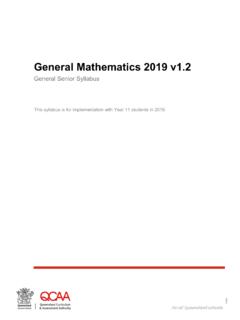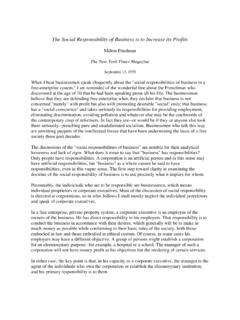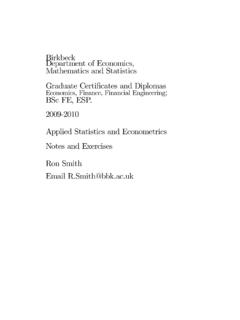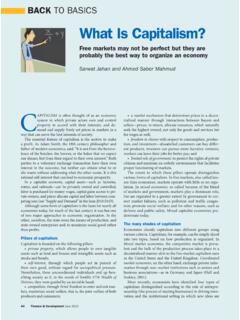Transcription of “Assessing the role of work Motivation on Employee ...
1 Ume School of Business and Economics Course: C-Level Thesis Supervisor: Peter Hult n Assessing the role of work Motivation on Employee performance . Author: Peter Ebong Ajang 1. ABSTRACT. The main purpose of this study was to assess the role of work Motivation on Employee performance . This study in an assessment of this purpose used deductive approach in which a qualitative survey was carried out among students at of Ume Business School (USBE) who are assumed to be future employees .The survey was intended to get their responses on what they feel is (are) the best factors that could motivate them as future employees among a list of ten motivational factors. In this light the study sets to identify the most ranked factors among the ten motivational factors.
2 The analysis from the empirical findings showed that Job satisfaction was the most ranked factor for both sub groups that made up the sample survey. However a study from previous researches used in this study showed that different results could be obtained from different groups of already working employees. This study therefore can be seen as an introduction to a more detailed study to be carried by future researchers on the field of Employee 's Motivation . 2. TABLE OF CONTENT. Pages Chapter One - - - - - - - - - - - - - - - - - - - - - - - - - - - - - - - - - - - - - - - - - - - - - - - - - - - - - -1. Introduction/Background- - - - - - - - - - - - - - - - - - - - - - - - - -- - - - - - - - - - - - - - - - - -1. Research question/problem statement - - - - - - - - - - - - - - - - - - - - - - - - - - - - - - - - - - -3.
3 Objectives/purpose of study - - - - - - - - - - - - - - - - - - - - - - - - -- - - - - - - - - - - - - - - - -3. Limitations and demarcations - - - - - - - - - - - - - - - - - - - - - - - -- - - - - - - - - - - - - - - - -3. Definitions - - - - - - - - - - - - - - - - - - - - - - - - - - - - - - - - - - - - - - - - - - - - - - - - - - - - - 4. Disposition - - - - - - - - - - - - - - - - - - - - - - - - - - - - - - - - - - - - - - - - - - - - - - - - - - - - - 5. Chapter Two- - - - - - - - - - - - - - - - - - - - - - - - - - - - - - - - - - - - - - - - - - - - - - - - - - - - - - 6. is Motivation - - - - - - - - - - - - - - - - - - - - - - - - - - - - - - - - - - - - - - - - - - - - - - - - 6. Motivational theories - - - - - - - - - - - - - - - - - - - - - - - - - - - - - - - - - - - - - - - - - - - - - - 8.
4 History and explanation of Maslow's Hierarchy of needs - - - - - - - - - - - - - - - - - - - - - 12. Organisational/managerial applications of Maslow need theory - - - - - - - - - - - - - - - - -14. Criticisms of Maslow's need theory- - - - - - - - - - - - - - - - - - - - - - - - - - - - - - - - - - - -15. Empirical studies on employees Motivation using Maslow's model- - - - - - - - - - - - - - -16. Chapter Three - - - - - - - - - - - - - - - - - - - - - - - - - - - - - - - - - - - - - - - - - - - - - - - - - - - -20. method- - - - - - - - - - - - - - - - - - - - - - - - - - - - - - - - - - - - - - - - - - - - - - - - -20. Choice of subject - - - - - - - - - - - - - - - - - - - - - - - - - - - - - - - - - - - - - - - - - - - - - - - -20. Perspective - - - - - - - - - - - - - - - - - - - - - - - - - - - - - - - - - - - - - - - - - - - - - - - - - - - - 22.
5 Preconception - - - - - - - - - - - - - - - - - - - - - - - - - - - - - - - - - - - - - - - - - - - - - - - - - - 22. Scientific ideal - - - - - - - - - - - - - - - - - - - - - - - - - - - - - - - - - - - - - - - - - - - - - - - - - -23. Scientific approach - - - - - - - - - - - - - - - - - - - - - - - - - - - - - - - - - - - - - - - - - - - - - - -24. Research method- - - - - - - - - - - - - - - - - - - - - - - - - - - - - - - - - - - - - - - - - - - - - - - - -25. Chapter Four - - - - - - - - - - - - - - - - - - - - - - - - - - - - - - - - - - - - - - - - - - - - - - - - - - - - 27. Sample - - - - - - - - - - - - - - - - - - - - - - - - - - - - - - - - - - - - - - - - - - - - - - - - - - - - - - -27. Data collection - - - - - - - - - - - - - - - - - - - - - - - - - - - - - - - - - - - - - - - - - - - - - - - - - -27.
6 Choice of investigating factors - - - - - - - - - - - - - - - - - - - - - - - - - - - - - - - - - - - - - - -28. Criticism of data - - - - - - - - - - - - - - - - - - - - - - - - - - - - - - - - - - - - - - - - - - - - - - - - -29. Data analysis - - - - - - - - - - - - - - - - - - - - - - - - - - - - - - - - - - - - - - - - - - - - - - - - - - -30. 3. Quality of research design - - - - - - - - - - - - - - - - - - - - - - - - - - - - - - - - - - - - - - - - - -30. Degree of generalisation- - - - - - - - - - - - - - - - - - - - - - - - - - - - - - - - - - - - - - - - - - - -32. Chapter Five - - - - - - - - - - - - - - - - - - - - - - - - - - - - - - - - - - - - - - - - - - - - - - - - - - - - - 33. General results - - - - - - - - - - - - - - - - - - - - - - - - - - - - - - - - - - - - - - - - - - - - - - - - - -33.
7 Gender (male/female) - - - - - - - - - - - - - - - - - - - - - - - - - - - - - - - - - - - - - - - - - - - - -36. Age group - - - - - - - - - - - - - - - - - - - - - - - - - - - - - - - - - - - - - - - - - - - - - - - - - - - - -37. Chapter Six - - - - - - - - - - - - - - - - - - - - - - - - - - - - - - - - - - - - - - - - - - - - - - - - - - - - - -38. Analysis of the empirical finding- - - - - - - - - - - - - - - - - - - - - - - - - - - - - - - - - - - - - -38. Gender - - - - - - - - - - - - - - - - - - - - - - - - - - - - - - - - - - - - - - - - - - - - - - - - - - - - - - - 42. Age group - - - - - - - - - - - - - - - - - - - - - - - - - - - - - - - - - - - - - - - - - - - - - - - - - - - - -43. Chapter Seven- - - - - - - - - - - - - - - - - - - - - - - - - - - - - - - - - - - - - - - - - - - - - - - - - - - - 45.
8 Conclusions - - - - - - - - - - - - - - - - - - - - - - - - - - - - - - - - - - - - - - - - - - - - - - - - - - - -45. Chapter Eight - - - - - - - - - - - - - - - - - - - - - - - - - - - - - - - - - - - - - - - - - - - - - - - - - - - - 49. Strengths and weaknesses - - - - - - - - - - - - - - - - - - - - - - - - - - - - - - - - - - - - - - - - - - 49. Contributions - - - - - - - - - - - - - - - - - - - - - - - - - - - - - - - - - - - - - - - - - - - - - - - - - - -49. Recommendations - - - - - - - - - - - - - - - - - - - - - - - - - - - - - - - - - - - - - - - - - - - - - - - 50. Reference list - - - - - - - - - - - - - - - - - - - - - - - - - - - - - - - - - - - - - - - - - - - - - - - - - - - - - 51. Appendix - - - - - - - - - - - - - - - - - - - - - - - - - - - - - - - - - - - - - - - - - - - - - - - - - - - - - - - -53.
9 List of tables Fig The process of employees Motivation - - - - - - - - - - - - - - - - - - - - - - - - - - - - - - - 10. Fig Hierarchy of needs /ERG theory- - - - - - - - - - - - - - - - - - - - - - - - - - - - - - - - - - - -13. List of tables Table Description of sub-groups and number of respondents - - - - - - - - - - - - - - - - - - -33. Table Collective rank order of motivating factors - - - - - - - - - - - - - - - - - - - - - - - - - - 34. Table Factors that influence respondents' rankings by sub-groups- - - - - - - - - - - - - - - -36. 4. CHAPTER ONE. INTRODUCTION. This chapter starts by presenting a background discussion of the selected topic of this thesis. At the end of this discussion the research question is formulated and the main purpose of this thesis (which is two folds) are established.
10 What this research hopes to contribute and the delimitation's of this study are also discussed. : Introduction /Background When looking at factors that affect job satisfaction, I find that Agency theory might be helpful as it explains the extent to which organisations need to think of their human resource responsible in producing the output needed by organisations to meet shareholders value. Agency theory is concerned with issues related to the ownership of the firm when that ownership is separated from the day-to-day running of the organisation. It assumes that in all but owner- managed organisations the owner or owners (known in agency theory as the principal ) of an organisation must vest authority to an agent -corporate management- to act on their behalf.










